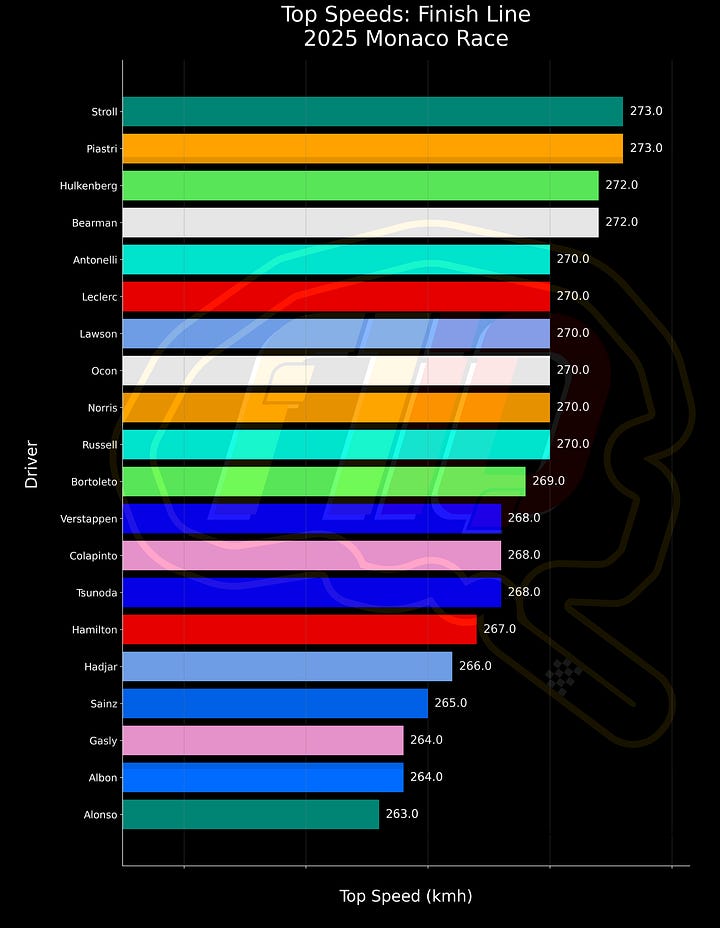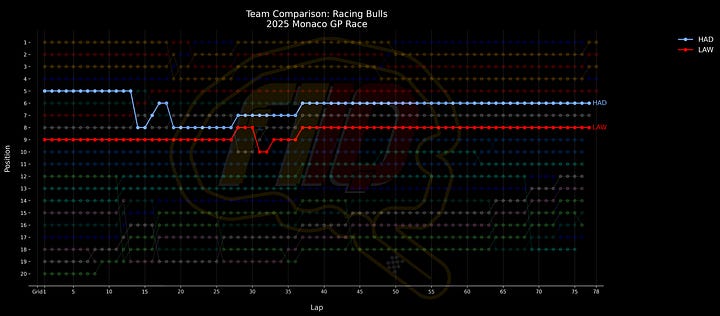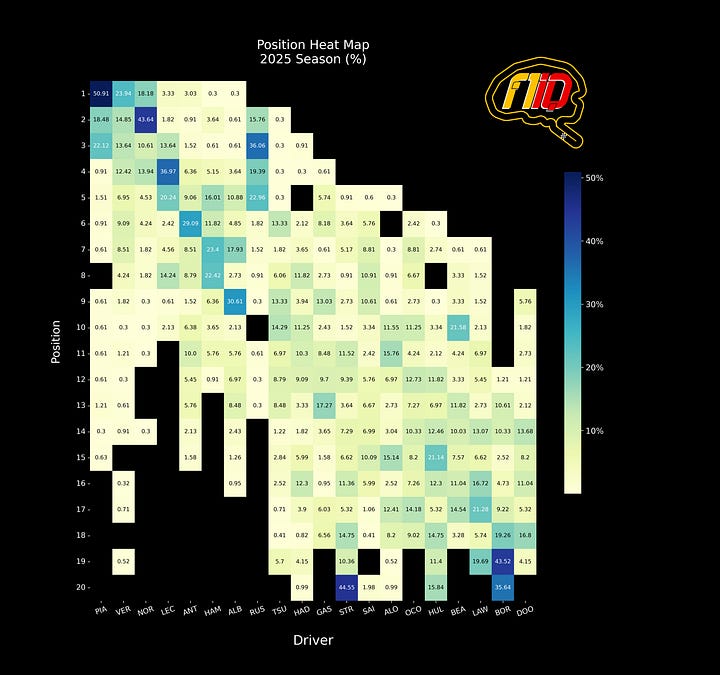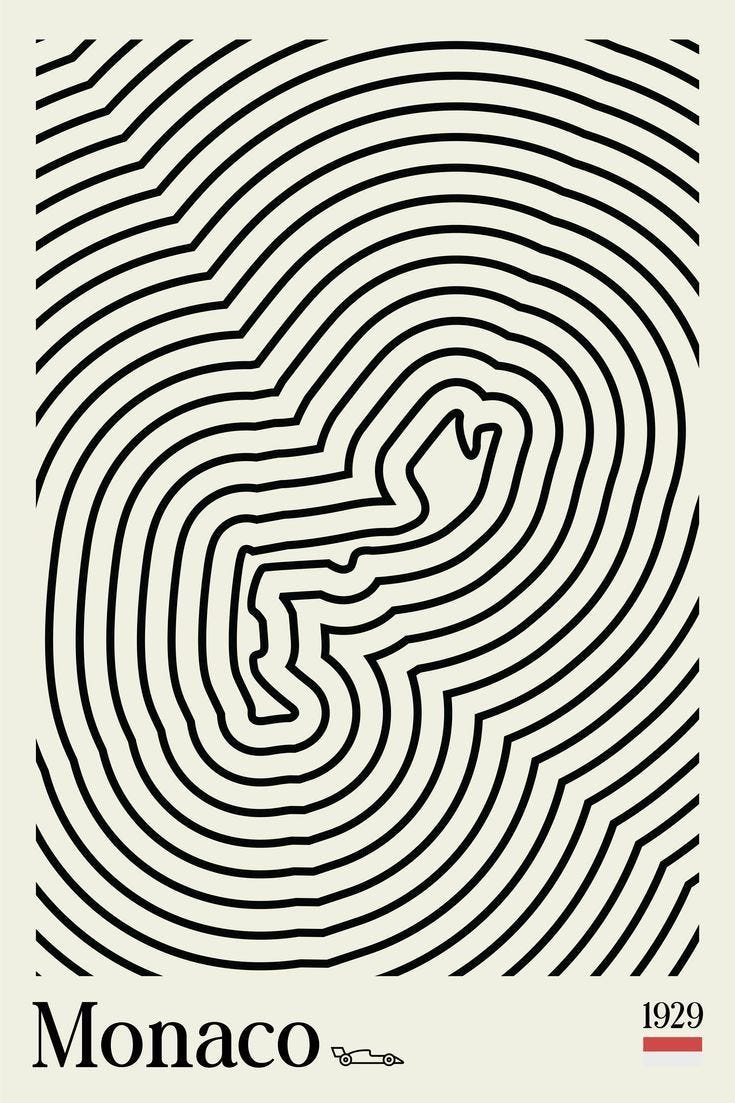Norris is Back
The erstwhile title favourite gets back in the swing of things, while Mercedes surprises everyone—but not in a good way
I quite enjoy the hypnotic quality of this art piece.
But not as much as I enjoyed the Monaco GP. At least the race as it happened up to Lewis Hamilton. Behind Hamilton, things get complicated. But not really impossible to enjoy, especially if you like malicious compliance.
Whatever that was we watched behind him was a racing farce and the best way possible for Formula One teams to tell the series bigwigs that their plan to “spice up the show” is stupid. Never, in the history of F1, have the bureaucrats been able to force teams to do what they should, and today was no different.
How did that new rule work out?
Not great, mate, not great at all.
The Monaco-only rule for this year was that all drivers would need to use 3 sets of tyres. So teams got working on how to subvert the goal of the rule and make it work in their favour.
According to an article posted by F1 itself, the goal of this rule was to “inject some excitement into the encounter, which takes place around Monte Carlo’s tight, twisty streets (meaning a lack of overtaking opportunities) and is commonly a one-stop affair.”
Was there excitement? Yes.
Were there different strategies? Sure.
Was the race better? Absolutely not because teams do not work for the show, they work for themselves. Ask Red Bull if they were bothered about winning all but one race across a season because people thought it was boring, and you will get a hearty laugh.
There were different strategies, some drivers stopped at the end of the first lap, others left both of their stops until the end, waiting for Safety Car or Virtual Safety Car periods to lose less time during their stops. And Mercedes basically forgot pitstops were necessary when it came to one of their drivers.
And Williams and MinardiRossoTauri brought their best strategy ideas, and I love them both for it.
Williams
The Grove-based team had Alexander Albon and Carlos Sainz starting P10 and 11, respectively. We discussed it in the Saturday review and also in the special post later which dealt with certain aspects of the action.
They told Sainz to hold the field back from Albon—meaning EVERYONE behind Sainz was crawling around, losing a few seconds each lap—while Albon hurried along to create a gap for his first stop.
Both Mercedes drivers, starting from P14 and 15, were stuck in this predicament, and it would cost them any chance of scoring points.
After Albon had used the 3 sets he had to, the Williams drivers SWITCHED positions right in front of George Russell, Albon now holding everyone back so Sainz could also pit twice.
Russell was, let’s say, not happy with the strategy and was not shy about making it known.
Ultimately, Williams played the rule perfectly and had a double scoring finish.
MinardiRossoTauri
MinardiRossoTauri, on the other hand, did not have their drivers next to each other at the start, but Liam Lawson also held everyone back until Isack Hadjar could pit. It allowed Hadjar to pit when he was so far ahead of the field that the French driver was bothering Lewis Hamilton more than being challenged by the rest of the midfield.
Hadjar had to deal with Esteban Ocon and Fernando Alonso in front of the backed up pack, but Alonso retired with a power unit issue before the halfway point of the race. Hadjar kept ahead of Ocon, who did not have a teammate to help him, and then held the position until the end.
Lawson, meanwhile, took advantage of Williams’ strategy to hold P8 throughout most of the race, meaning the team scored a P6 and 8 double points finish, while Williams had to settle for P9 and 10. Ocon came home in P7, Bearman never managing to reach the points after his 10-place grid penalty.
Williams leaves Monaco with 3 points, still in 5th place in the Constructors’ Championship with 54 points, but MinardiRossoTauri scored 12 and jumped up to 22 and 6th place, dropping non-scoring Aston Martin to 8th, and closing in on Haas’ 6th position, the USA team hauling 6 points only.
Verdict
As is customary, F1 bigwigs try to create artificial excitement for people who need 250 overtakes to consider a race entertaining, and made it considerably worse.
Teams were always going to abuse the rule, and it was never going to have the desired effect. Yes, there were more changes of position, but overtaking is still harder than diamond, so it was always going to be a pitstop battle.
But it turned out to be a “who can keep people behind them best”, and everything behind Hamilton in 5th place was just a farce.
However, it pleases me to no end to see the remarkable strategy teams around the grid handing upper management their asses. There is NO rule a group of engineers cannot subvert, no matter how detailed you make the rule. It has never worked and it will never work. And I find it beautiful.
I have said it before, I will say it again, and I will never stop saying it: if you cannot appreciate what the drivers are doing in Monaco, maybe F1 is not for you.
It is the greatest display of skill in the F1 season and the most gruelling test of the drivers. What’s not to like?
At The Start
Monaco has one basic rule, as we discussed before: if you start from pole, you better keep your place into the first turn. And, if you did not watch it yet, go check out what can happen if you fail to do so by watching the Formula 2 Feature Race. It is just like an iRacing open lobby in real life. A marvel to behold.
Anyway, Lando Norris had one job and one job only: do not let anyone get past you into Saint Devote. He had a brilliant get away, had a major lock-up into the first corner but still held Charles Leclerc behind him, and everything was looking pretty.
Leclerc had Oscar Piastri following him, and Max Verstappen trailed them, leading Hamilton.
Behind this group, the already-discussed chaos was going on. Lawson was holding Albon back, Sainz was holding the rest of the pack back, and the race was slightly farcical.
Kimi Andrea Antonelli lost a place to Gabriel Bortoleto but immediately sent his car to the inside of the Sauber, who was pushed into the barrier. Everyone expected a Safety Car, and there were a few stops already.
Yuki Tsunoda started on the soft compound and stopped for a set of hard tyres, Pierre Gasly and Oliver Bearman started on mediums and came out on mediums and hards, respectively. Bortoleto pitted for new bits for his car and came out with the hard tyre installed.
Race Direction did not send out the Safety Car, but did activate the Virtual sort, so the field was neutralised but without much change in the gaps between them. Once things got back under way, Piastri lost a bit of time to Leclerc and the fight at the front was mostly the five cars trundling around Monaco trying to keep all gaps stable.
Until Norris pitted after 20 laps, the order of the first four held, while Hamilton was stuck behind Hadjar and Alonso. Once these cars pitted, Hamilton was 5th, and there he would stay until the end. Not the most fun race the 7-time champion has ever had at Monaco.
Behind, there was not a lot of movement either, because of Lawson and Sainz executing their teams’ strategies.
Mercedes could not get past Sainz, so Russell and Antonelli just sat there hoping they would have an opportunity somehow.
Once the stops started, the order changed, as we can see in the lap chart, but it was not the most exciting thing to happen.
Until Pierre Gasly clobbered Tsunoda’s car as they approached the Nouvelle Chicane, wrecking the Alpine and probably bending a few things in the Red Bull. Gasly cruised to the pits and retired, but because he did not stop on track, no Safety Car was necessary for this either.
Ferrari was on fire with their pitstops, both Hamilton and Leclerc taking advantage of the pit crew’s improvement to ace their stops, but Norris and McLaren had things under control. Especially since Norris’ first stop was on par with the Ferrari ones, while Piastri had a 4+ second stop and fell back, so the leader only had to worry about Leclerc. For a while, at least.
After Norris and Leclerc pitted for the second time, Verstappen carried on at the front of the field. They caught up with Verstappen, obviously, and the Red Bull kept waiting, waiting, waiting for anything to happen which could help Verstappen keep the lead while still putting on his 3rd set of tyres.
But once Norris and Leclerc, and later Piastri, were inside Verstappen’s SC/VSC pit window, the only card which could save him was a red flag, so the four cars went around and around in a line. Verstappen would have to pit at some point, and because the red flag never came, the Red Bull went in at the end of the penultimate lap, ceding the lead and the win to Norris.
And that is how they finished, McLaren with two cars on the podium, Leclerc with his 2nd podium at his home race, and Hamilton so far back that Verstappen stopped and still came out in 4th place.
Hamilton was almost one minute back when Verstappen pitted for the second time, so no danger there, and Hadjar in 6th place was already a lap down, so Hamilton was not under any pressure whatsoever and that is how it all finished.
Why did Ferrari not tell Hamilton to push harder to at least harass Verstappen when the Red Bull was backing Norris into Leclerc and both of them into Piastri? As Shrek would say, good question. One we will never get the answer to, probably, but it is a good question.
Hamilton clearly had pace, and even pushed a bit for a few laps here and there, as you can see above, but he could have done much more, especially when Verstappen was doing laps in the 16s. Alas, no one said anything, and he finished in 5th place.
MinardiRossoTauri and Williams nailed the strategy, and were rewarded with points with all drivers, Ocon the only one to crack the Top 10 for Haas.
If we look at the race’s heatmap, there were obvious groups in the race and getting past the roadblocks to move from block to block.
The top 4 were by themselves, Hamilton formed a solo block once he got to 5th place, and everyone behind Russell swapped positions multiple times during pitstops.
So there were plenty of positions changes in the bottom 10, but was that a really exciting race? Especially since, if you are watching it without multiple screens, you mostly get the leaders and only see the mid to back pack when something happens on track.
Behind the trailing Williams car, there were a bunch of drivers and teams that can only be described as disinterested.
No doubt that getting out of the trap Sainz represented was tough, but no one tried anything, just trundled around until the end. Actually, that is a lie. Sauber did try something by pitting Bortoleto multiple times, and it did work to push him past Stroll and Nico Hülkenberg, but obviously no points for finishing all in the teens.
James Vowles, Williams Team Principal, summed the day perfectly after the race. Vowles admitted that they had played by the rules, had maximised their result, and if the people watching it did not enjoy it, that is a pity, but nothing to do with him.
Which I find extremely difficult to disagree with.
Russell Goes Rogue
Eventually, Russell was so frustrated by Albon’s tactics that the Mercedes cut through the Nouvelle Chicane and, when told to give the place back, said he rather take the 5-second penalty.
Which is fair, if you have just spent 70 laps being frustrated. The race stewards found that exchange exceedingly funny and rewarded Russell, for his cheek and humour while driving, with a drive-through penalty instead.
Which was the final blow to Russell’s chance of scoring a point.
If you look at their lap chart, it is not the most exciting race in the world…
But there is an extra consideration.
Russell is the president of the Grand Prix Drivers Association, which has been responsible for many improvements to Formula One in the past. Not the ideal look for the president of the GPDA to say that he is eating a sporting penalty because he is frustrated by the race he is having because of another team’s strategy.
Although I would say that Russell and Antonelli had a terrible race because they had a terrible Saturday in the one race on the calendar in which you cannot have a bad Saturday.
Just a thought.
One Quick Rant
Why do we keep seeing drivers’ girlfriends and wives, especially with their names and occupations? Who is interested in this information and cannot find it on the internet—but why would you do so because that would be creepy?
And how is this not extremely creepy to everyone watching the broadcast?
The girlfriends, especially, are usually very young—as are the drivers—and this should not be cool.
OK, rant over.
More Data
We have top speeds and best sector times, as usual.








And the weather, which was not really a factor over the weekend.


And we have lap charts for the teams, highlighting their drivers!









Season Heatmaps
Piastri continues to hold the lead for laps in first place even with a bad race at Monaco. Leclerc, on the other hand, has most of his laps in 4th place but is the only driver to not have dropped out of the Top 10, while Bortoleto still has not completed one lap in it.


The Championship Picture
Norris started the season with a win and appeared to be cementing his status as the title favourite—even if the win at Melbourne was not an easy one once the rain hit.
But in the subsequent rounds, things got worse and worse for the McLaren driver, as he faltered and Piastri started to dominate, culminating in the three straight wins from Bahrain to Miami.
Norris’ win in the Sprint race in Miami was a nice stroke of luck, but it did not make up for the lack of triumphs on Sundays, but he might have righted the ship now.
Thanks to consistent scoring through his winless streak, Norris is only 3 points behind Piastri, with Verstappen trailing Norris by 22 points—i.e. dangerously close.
The McLaren drivers still have the best car, and they should open a comfortable gap to Verstappen if things go to plan. That, however, is the crux of the matter, as anyone who ever had the pleasure of hearing a race called by the legendary Murray Walker knows. Things will happen, and many of them will not be the ones McLaren wants.
We have seen it a few times, when a dominant team has two drivers fighting and because the drivers are evenly matched, they keep trading blows. While their lead to a challenger who has their team’s full support and attention creeps closer and closer.
And every so often, that sneaky challenger lucks out and robs the faster team of the WDC. Considering Verstappen’s quality and Red Bull’s proficiency in title fights, if I were in Zak Brown’s position, I would keep the fire burning as hot as possible until the numbers say they are safe. Which, if you have ever seen Zak Brown do anything, he is bound to do.
Brown’s rebuild of McLaren—not just the F1 team, but the entire company—is an outstanding display of competence, dedication, love of cars and motorsports, and what can be achieved when everyone buys into a vision. It would be a great pity if the work the entire Woking team has done in the last few years were to be sullied by losing out on a double championship season.


At the lower end, Hadjar and Lawson benefited from the team’s strategy and scored heavily. Lawson, especially, finally left the nought zone, which is still a bit congested with three active drivers stuck there—Alonso, Bortoleto, and Colapinto.
Alonso again failed to score, making it 8 races without a point, his worst start to a season since 2015, when he scored for the first time in the 9th race.
In the Constructors’ Championship, McLaren is still running away with it, but the Monaco result created a nice traffic jam between Mercedes, Red Bull, and Ferrari.
Williams has a buffer from the rest of the midfield, and with generally only the lower scoring positions available, it could be a difficult mountain for any other team to climb to reach them. Especially as Albon and Sainz are scoring with regularity.
As their drivers, MinardiRossoTauri jumped up substantially, and are closing in on Haas. The trailing three have now failed to score in three straight races at least, with Sauber having done so only once in the first race.















